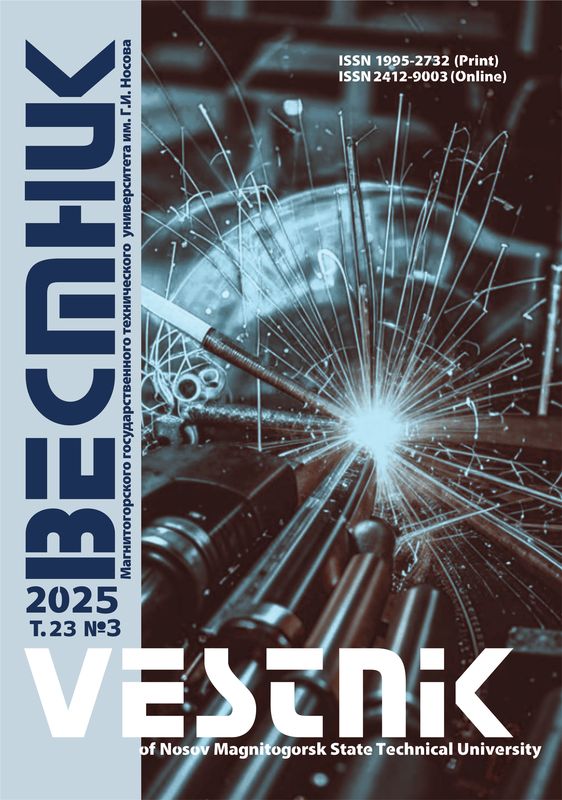DOI: 10.18503/1995-2732-2024-22-4-44-49
Abstract
Problem Statement (Relevance). The article presents the results of laboratory reseaches on increase the grindability of gold ore recommended for implementation. One of the most effective methods for increasing grindability such as reagent treatment is considered. The effect achieved when using grinding intensifiers is explained by a decrease in the adhesion of small particles to larger ones and the Rehbinder effect. The object of the research was a technological sample of refractory gold-bearing ore of the quartz-pyrite type. Objectives. It's required to conduct technological research to increase the productivity of the grinding department of the gold recovery plant with minimal capital and operating costs, which explains the authors' choice in favor of reagent treatment. Methods Applied. Sample preparation, which consists in bringing a representative sample to a machine size class suitable for a laboratory mill -2 + 0 mm, averaging it, dividing it into samples, determining the material composition of the sample was used. The elemental and phase composition were determined by chemical and X-ray phase methods. A set of techniques for studying the physical and mechanical properties of samples with determination of the shreddability and specific surface area was applied. Result. Three sets of experiments were conducted to select the grinding time and the effect of reagents on grindability. The optimal time for grinding a sample in a laboratory mill without adding reagents was determined. Based on the results of preliminary studies, lime, Antiprex D and DP-OMC 1127 reagents were selected as the most effective for this material. The effect of reagent consumption of grinding intensifiers on the content of the estimated size of -74 microns class in the ground product was revealed. The possibility of increasing the grindability of ore using the Antiprex D grinding intensifier together with the addition of lime was established. Based on the experiment results, a decision was made to abandon the use of DP-OMC 1127 reagent. The optimal reagent mode for ore grinding will increase the specific productivity of the mills installed at the plant by 1.12 times, the total productivity of the existing plant can be increased by 42 thousand tons per year.
Keywords
grindability, gold ore, surfactants, grinding intensifiers, calculated size class
For citation
Grishin I.A., Degodya E.Yu., Gmyzina N.V., Kutlubaev I.М., Zoteev O.V. Study of the Influence of Grinding Intensifier Reagents on the Results of Grinding Gold Ore. Vestnik Magnitogorskogo Gosudarstvennogo Tekhnicheskogo Universiteta im. G.I. Nosova [Vestnik of Nosov Magnitogorsk State Technical University]. 2024, vol. 22, no. 4, pp. 44-49. https://doi.org/10.18503/1995-2732-2024-22-4-44-49
1. Chanturia V.A. Innovative processes in technologies for processing refractory mineral raw materials. Geologiya rudnyh mestorozhdenij [Geology of ore deposits], 2008;50(6):558-568. (In Russ.)
2. Khurmamatov A., Sultanova M., Mukhamedbaev A. Intensifying the cement grinding process. Universum: tekhnicheskie nauki [Universum: technical sciences]. 2024;(5-8(122)):57-62. EDN XNXAEI.
3. Gmyzina N.V. Intensification of the converter slag grinding process. Vestnik Magnitogorskogo gosudarstvennogo tekhnicheskogo universiteta im. G.I. Nosova [Vestnik of the Nosov Magnitogorsk State Technical University], 2009;(3(27)):13-14. (In Russ.) EDN KVLIDL.
4. Zamottin P. A., Lobanov V.G. Intensification of the process of grinding gold-bearing ore using surfactants and additional ultrasound treatment. Vestnik Magnitogorskogo gosudarstvennogo tekhnicheskogo universiteta im. G.I. Nosova [Vestnik of the Nosov Magnitogorsk State Technical University]. 2018;16(3):25-32. (In Russ.). DOI:10.18503/1995-2732-2018-16-3-25-32.
5. Shakhova L.D., Cherkasov R.A., Berezina N.M., Manelyuk D.B. Classification of technological additives in cement grinding. Fundamentalnye issledovaniya [Fundamental research], 2014;(12-2):295-299. (In Russ.)
6. Goryunov Yu.V., Pertsov N.V., Summ B.D. Rehbinder effect. Moscow, 1966. (In Russ.)
7. Rehbinder P.A., Shchukin E.D. Surface phenomena in solids in the processes of their deformation and destruction. Uspekhi fizicheskih nauk [Advances in Physical Sciences], 1972;108(1):3. (In Russ.)
8. Somani A., Nandi T.K., Pal S.K., Majumder, A.K. Pretreatment of rock prior to communion - A critical review of present practices. Internation Journal of Mining Science and Technology. 2017;27(2):339-348.
9. Chakka V.M., Altuncevahir B., Jin Q., Li Y., Liu J.P. Surfactant assisted ball milling. Journal of applied physics. 2006;99:99-101.
10. Mahbub Ullah, Md. Edqub Ali. Surfactant-assisted ball milling. University of Malaya. 2013.
11. Mitrofanov G.V., Chernousenko E.V., Golubev V.Yu., Matveeva E.V. Use of grinding intensifiers in the processing of iron-containing ores. Obogashchenie rud [Ore enrichment], 2020;(3):3-7. (In Russ.) DOI: 10.17580/or.2020.03.01. EDN GBEYBM.












